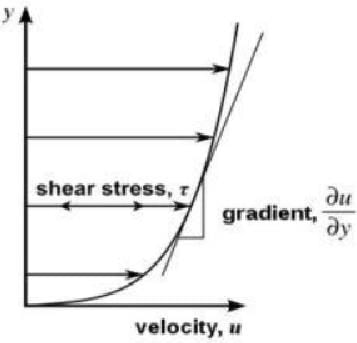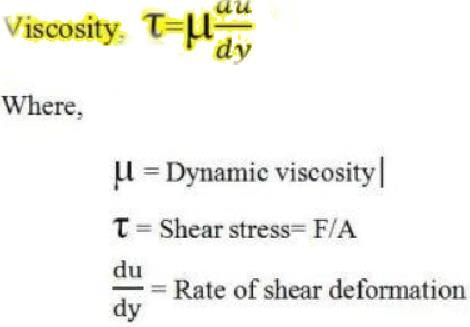Civil Engineering (CE) Exam > Civil Engineering (CE) Questions > Newton's law of viscosity states thata)th...
Start Learning for Free
Newton's law of viscosity states that
- a)the shear stress applied to the fluid is inversely proportional to the velocity gradient (du/dy)
- b)the shear stress applied to the fluid is directly proportional to the velocity gradient (du/dy)
- c)the shear stress applied to the fluid is inversely proportional to the specific weight of the fluid.
- d)the shear stress applied to the fluid is directly proportional to the specific weight of the fluid
Correct answer is option 'B'. Can you explain this answer?
Verified Answer
Newton's law of viscosity states thata)the shear stress applied to...


Most Upvoted Answer
Newton's law of viscosity states thata)the shear stress applied to...
Newton's Law of Viscosity in Fluid Mechanics
The Newton's Law of Viscosity is an important concept in the field of fluid mechanics. It is used to describe the behavior of fluids when they are subjected to shear forces.
Shear Stress and Velocity Gradient
According to the Newton's Law of Viscosity, the shear stress applied to a fluid is directly proportional to the velocity gradient. This means that the greater the velocity gradient, the greater the shear stress.
The shear stress applied to a fluid is defined as the force per unit area that is applied to the fluid when it is subjected to a shear force. The velocity gradient is defined as the change in velocity of the fluid per unit distance in the direction of the shear force.
Mathematically, this can be expressed as:
τ = μ (du/dy)
Where τ is the shear stress, μ is the dynamic viscosity of the fluid, and (du/dy) is the velocity gradient.
Dynamic Viscosity
The dynamic viscosity of a fluid is a measure of its resistance to flow. It is defined as the ratio of the shear stress to the velocity gradient.
Mathematically, this can be expressed as:
μ = τ/(du/dy)
Conclusion
In conclusion, Newton's Law of Viscosity states that the shear stress applied to a fluid is directly proportional to the velocity gradient. This relationship is expressed mathematically by the equation τ = μ (du/dy). The dynamic viscosity of a fluid is a measure of its resistance to flow and is defined as the ratio of the shear stress to the velocity gradient.
The Newton's Law of Viscosity is an important concept in the field of fluid mechanics. It is used to describe the behavior of fluids when they are subjected to shear forces.
Shear Stress and Velocity Gradient
According to the Newton's Law of Viscosity, the shear stress applied to a fluid is directly proportional to the velocity gradient. This means that the greater the velocity gradient, the greater the shear stress.
The shear stress applied to a fluid is defined as the force per unit area that is applied to the fluid when it is subjected to a shear force. The velocity gradient is defined as the change in velocity of the fluid per unit distance in the direction of the shear force.
Mathematically, this can be expressed as:
τ = μ (du/dy)
Where τ is the shear stress, μ is the dynamic viscosity of the fluid, and (du/dy) is the velocity gradient.
Dynamic Viscosity
The dynamic viscosity of a fluid is a measure of its resistance to flow. It is defined as the ratio of the shear stress to the velocity gradient.
Mathematically, this can be expressed as:
μ = τ/(du/dy)
Conclusion
In conclusion, Newton's Law of Viscosity states that the shear stress applied to a fluid is directly proportional to the velocity gradient. This relationship is expressed mathematically by the equation τ = μ (du/dy). The dynamic viscosity of a fluid is a measure of its resistance to flow and is defined as the ratio of the shear stress to the velocity gradient.

|
Explore Courses for Civil Engineering (CE) exam
|

|
Similar Civil Engineering (CE) Doubts
Newton's law of viscosity states thata)the shear stress applied to the fluid is inversely proportional to the velocity gradient (du/dy)b)the shear stress applied to the fluid is directly proportional to the velocity gradient (du/dy)c)the shear stress applied to the fluid is inversely proportional to the specific weight of the fluid.d)the shear stress applied to the fluid is directly proportional to the specific weight of the fluidCorrect answer is option 'B'. Can you explain this answer?
Question Description
Newton's law of viscosity states thata)the shear stress applied to the fluid is inversely proportional to the velocity gradient (du/dy)b)the shear stress applied to the fluid is directly proportional to the velocity gradient (du/dy)c)the shear stress applied to the fluid is inversely proportional to the specific weight of the fluid.d)the shear stress applied to the fluid is directly proportional to the specific weight of the fluidCorrect answer is option 'B'. Can you explain this answer? for Civil Engineering (CE) 2025 is part of Civil Engineering (CE) preparation. The Question and answers have been prepared according to the Civil Engineering (CE) exam syllabus. Information about Newton's law of viscosity states thata)the shear stress applied to the fluid is inversely proportional to the velocity gradient (du/dy)b)the shear stress applied to the fluid is directly proportional to the velocity gradient (du/dy)c)the shear stress applied to the fluid is inversely proportional to the specific weight of the fluid.d)the shear stress applied to the fluid is directly proportional to the specific weight of the fluidCorrect answer is option 'B'. Can you explain this answer? covers all topics & solutions for Civil Engineering (CE) 2025 Exam. Find important definitions, questions, meanings, examples, exercises and tests below for Newton's law of viscosity states thata)the shear stress applied to the fluid is inversely proportional to the velocity gradient (du/dy)b)the shear stress applied to the fluid is directly proportional to the velocity gradient (du/dy)c)the shear stress applied to the fluid is inversely proportional to the specific weight of the fluid.d)the shear stress applied to the fluid is directly proportional to the specific weight of the fluidCorrect answer is option 'B'. Can you explain this answer?.
Newton's law of viscosity states thata)the shear stress applied to the fluid is inversely proportional to the velocity gradient (du/dy)b)the shear stress applied to the fluid is directly proportional to the velocity gradient (du/dy)c)the shear stress applied to the fluid is inversely proportional to the specific weight of the fluid.d)the shear stress applied to the fluid is directly proportional to the specific weight of the fluidCorrect answer is option 'B'. Can you explain this answer? for Civil Engineering (CE) 2025 is part of Civil Engineering (CE) preparation. The Question and answers have been prepared according to the Civil Engineering (CE) exam syllabus. Information about Newton's law of viscosity states thata)the shear stress applied to the fluid is inversely proportional to the velocity gradient (du/dy)b)the shear stress applied to the fluid is directly proportional to the velocity gradient (du/dy)c)the shear stress applied to the fluid is inversely proportional to the specific weight of the fluid.d)the shear stress applied to the fluid is directly proportional to the specific weight of the fluidCorrect answer is option 'B'. Can you explain this answer? covers all topics & solutions for Civil Engineering (CE) 2025 Exam. Find important definitions, questions, meanings, examples, exercises and tests below for Newton's law of viscosity states thata)the shear stress applied to the fluid is inversely proportional to the velocity gradient (du/dy)b)the shear stress applied to the fluid is directly proportional to the velocity gradient (du/dy)c)the shear stress applied to the fluid is inversely proportional to the specific weight of the fluid.d)the shear stress applied to the fluid is directly proportional to the specific weight of the fluidCorrect answer is option 'B'. Can you explain this answer?.
Solutions for Newton's law of viscosity states thata)the shear stress applied to the fluid is inversely proportional to the velocity gradient (du/dy)b)the shear stress applied to the fluid is directly proportional to the velocity gradient (du/dy)c)the shear stress applied to the fluid is inversely proportional to the specific weight of the fluid.d)the shear stress applied to the fluid is directly proportional to the specific weight of the fluidCorrect answer is option 'B'. Can you explain this answer? in English & in Hindi are available as part of our courses for Civil Engineering (CE).
Download more important topics, notes, lectures and mock test series for Civil Engineering (CE) Exam by signing up for free.
Here you can find the meaning of Newton's law of viscosity states thata)the shear stress applied to the fluid is inversely proportional to the velocity gradient (du/dy)b)the shear stress applied to the fluid is directly proportional to the velocity gradient (du/dy)c)the shear stress applied to the fluid is inversely proportional to the specific weight of the fluid.d)the shear stress applied to the fluid is directly proportional to the specific weight of the fluidCorrect answer is option 'B'. Can you explain this answer? defined & explained in the simplest way possible. Besides giving the explanation of
Newton's law of viscosity states thata)the shear stress applied to the fluid is inversely proportional to the velocity gradient (du/dy)b)the shear stress applied to the fluid is directly proportional to the velocity gradient (du/dy)c)the shear stress applied to the fluid is inversely proportional to the specific weight of the fluid.d)the shear stress applied to the fluid is directly proportional to the specific weight of the fluidCorrect answer is option 'B'. Can you explain this answer?, a detailed solution for Newton's law of viscosity states thata)the shear stress applied to the fluid is inversely proportional to the velocity gradient (du/dy)b)the shear stress applied to the fluid is directly proportional to the velocity gradient (du/dy)c)the shear stress applied to the fluid is inversely proportional to the specific weight of the fluid.d)the shear stress applied to the fluid is directly proportional to the specific weight of the fluidCorrect answer is option 'B'. Can you explain this answer? has been provided alongside types of Newton's law of viscosity states thata)the shear stress applied to the fluid is inversely proportional to the velocity gradient (du/dy)b)the shear stress applied to the fluid is directly proportional to the velocity gradient (du/dy)c)the shear stress applied to the fluid is inversely proportional to the specific weight of the fluid.d)the shear stress applied to the fluid is directly proportional to the specific weight of the fluidCorrect answer is option 'B'. Can you explain this answer? theory, EduRev gives you an
ample number of questions to practice Newton's law of viscosity states thata)the shear stress applied to the fluid is inversely proportional to the velocity gradient (du/dy)b)the shear stress applied to the fluid is directly proportional to the velocity gradient (du/dy)c)the shear stress applied to the fluid is inversely proportional to the specific weight of the fluid.d)the shear stress applied to the fluid is directly proportional to the specific weight of the fluidCorrect answer is option 'B'. Can you explain this answer? tests, examples and also practice Civil Engineering (CE) tests.

|
Explore Courses for Civil Engineering (CE) exam
|

|
Signup for Free!
Signup to see your scores go up within 7 days! Learn & Practice with 1000+ FREE Notes, Videos & Tests.


























